Big Red (or his offspring) may one day help scientists restore iconic Florida coral reefs
SUMMERLAND KEY – Meet Big Red, a Caribbean king crab captured in the wild off of the upper Florida Keys that currently lives in climate controlled raceways at Mote Marine Laboratory & Aquarium’s Elizabeth Moore International Center for Coral Reef Research & Restoration.
Before he was captured earlier this year, Big Red had already lost his left claw and a left rear leg,
At the Summerland Key lab, Big Red killed all the other males in the raceway where he resides, so he could mate with all the females.
Earlier: oral health highlighted at start of first phase of Mission Iconic Reefs
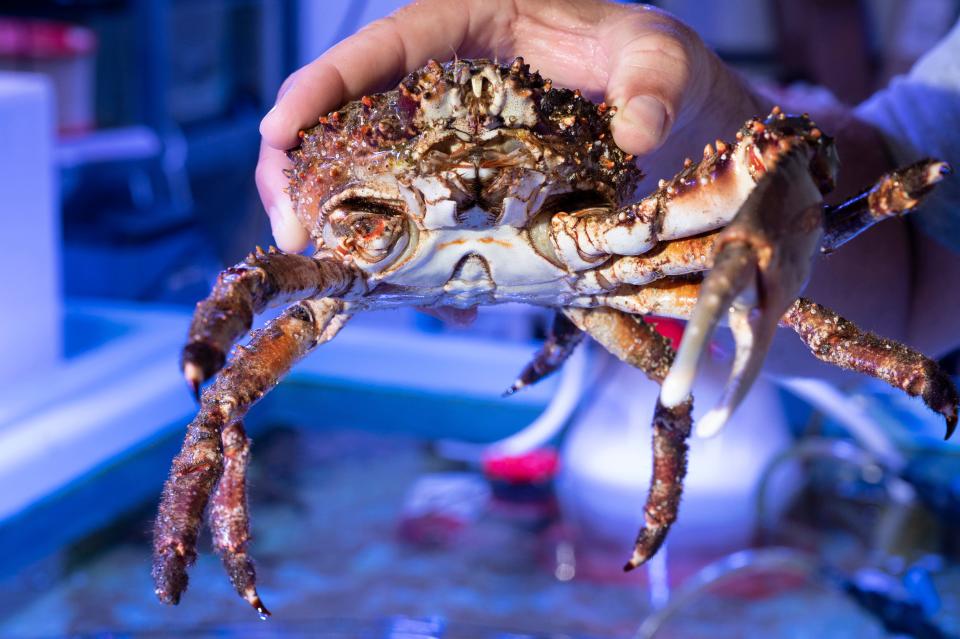
“When they get to that size, they get territorial and they get antagonistic,” said Jason Spadaro, a postdoctoral scientist at Mote’s Summerland Key complex, which is also referred to as IC2R3.
Big Red’s offspring are seen as one of several keys to the success of Mission Iconic Reefs – a $100 million effort to restore coral at seven sites along the Florida Reef Tract, off the state's southern tip.
Related: Complicated quest to save coral reefs
Mote is one of seven entities enlisted by the National Oceanic and Atmospheric Administration – along with The Florida Aquarium, the Coral Restoration Foundation, Florida Department of Environmental Protection, Florida Fish and Wildlife Commission’s Fish and Wildlife Research Institute, Reef Renewal and The Nature Conservancy – to partner on the plan, unveiled in December 2019.
That three–phase plan has an ultimate goal of restoring 3 million square feet of coral reefs – roughly the size of 52 football fields.
That would increase coral coverage on those seven reefs – the Carysfort Reef Complex and Horseshoe Reef in the upper keys; Cheeca Rocks and Sombrero Key in the middle keys; and Looe Key, Newfound Harbor Patches and Eastern Dry Docks in the lower keys – from the current 2% to what is hoped to be 25% by 2035.
Much of that new coral is being cultivated in land-based nurseries and later planted on those seven sites, as well as other sections of the Florida Reef Tract.
In August 2020, lab-grown coral planted near the Newfound Harbor site spawned in the wild – proof that the coral can propagate on its own.
Related: Mote scientists observe lab-grown coral spawn in the wild
As part of the restoration process, nuisance algae which retain sediment and choke off potential coral growth, must be removed.
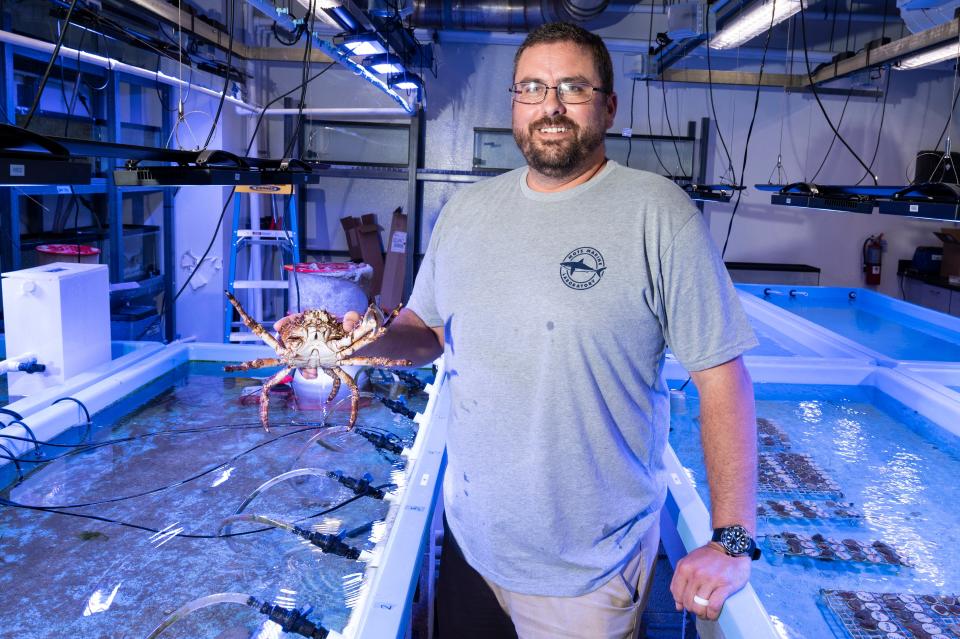
That’s where Big Red – or rather his offspring – come in, said Spadaro, who had been assistant professor of marine science and technology at the College of the Florida Keys before he joined Mote in December and brought his Caribbean king crab research with him.
At this point Spadaro had anticipated having four or five juvenile crabs at the lab on Summerland Key.
“We have something like 12,000 crabs on campus now and more coming every week,” Spadaro said.
Those crabs will be introduced into areas of the reef to control the algae, so the coral can thrive.
As part of the partnership, the University of Florida’s Institute of Food and Agricultural Sciences and the Florida Aquarium will spawn and breed long-spined urchins.
Algae grazing a key to coral health
“Lots of stuff grazes algae that compete with coral,” Spadaro said.
Long-spined sea urchins, also known as Diadima antillarum, are considered ideal to control algae on reefs in the Caribbean, but more than 90% of the population died off in the early 1980 – allowing algae to flourish and stunt coral growth.
“Forever, they were considered the keystone herbivore,” Spadaro said. “They were the species we needed to get back in order to remove algae.”
Caribbean king crabs are effective herbivores too, but typically exist at a population density of about one crab per square kilometer.
When algae gets too big or tough for the sea urchins, the crabs can still munch away.
Plus, sea urchins can also erode portions of the reef under the algae.
If there’s no coral replacing the calcium the urchins erode, that, too, is bad for a reef's long-term health.
“The crabs will eat all the algae that the urchins will eat and all the chemically and physically defended stuff that they won’t,” Spadaro said.
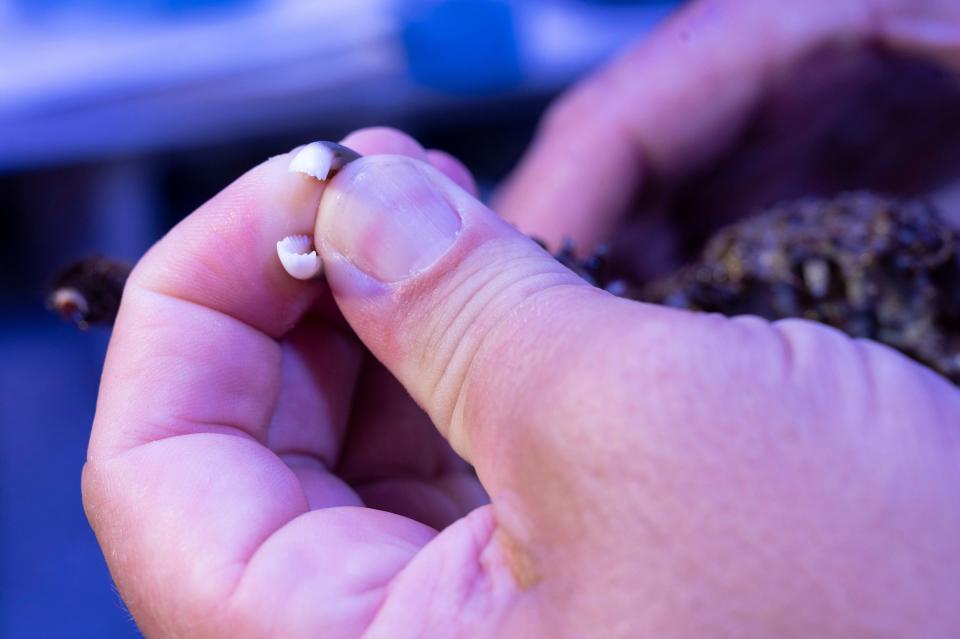
The dentitian on the tips of a Caribbean king crab claw have evolved to be very effective at harvesting algae.
“You see the dentitin on the claws,” Spadaro said, while showing off the tip of a claw of a female crab in his left thumb and forefinger, “it's almost like a horseshoe and it’s really well adapted to very delicately pinching and plucking the algae off of the reef.
“They don’t remove any of the calcium,” he added. “They’ve got that on the urchins.”
Algae can directly smother and shade coral, and cover an area of a reef so little coral babies can’t physically land and settle, Spadaro noted. The algae use nitrogen and phosphorus from the water column to build DNA, combining that with the sugars they produce through photosynthesis.
If the algae strip so much nitrogen and phosphorus out of the water that they can’t produce tissue, they can’t just turn off the photosynthesis, Spadaro noted. So they keep producing sugars that get dumped into the water column and turn into organic carbon that feeds microbes like bacteria and viruses.
“So if you have a really heavy covering biomass of algae without rough nitrogen for them to keep growing or when they outgrow the amount of nitrogen that’s there, they start dumping sugar into the water which causes bacteria and microbes to go nuts, which can cause diseases which kills off the coral, releases more nitrogen, brings up more algae – it’s this vicious cycle,” Spadaro said.
Provoking change
Spadaro and other scientists are studying to see whether the Caribbean king crabs – which are nocturnal – can help break that cycle, though to do so would involve introducing a larger number of crabs than typically occur in the wild.
“The only reason that we’re talking about increasing their numbers is they’re a native species but they’re naturally occurring at low densities,” Spadaro said. “On a natural reef in Florida or throughout the Caribbean you’ll find one crab per square kilometer of reef but that’s not enough for them to have the effect that we’re after – especially as we’ve lost coral and gained algae."
The target density to remove the excess algae and then give coral a chance to thrive is about one crab per square meter.
“That’s a huge, huge number when you start looking at the landscape scale,” Spadaro said. “Really we’re still at the experimental stage.”
Plans call for crabs to be born at a 6,000 square-foot hatchery tank at the Mote Aquaculture Research Park in Sarasota – which would meet the demands of Mission Iconic Reefs, which is where the bulk of Spadaro’s funding now comes.
Those baby crabs would be transported to Summerland Key to grow to release size in two to three months, while being acclimated to the wild.
Baby Caribbean king crabs are like candy to most predators in the wild, Spadaro said. The hope is that at age two or three months, more crabs would survive.
Still, that acclimation may even include prodding the baby crabs with grouper, snapper and spiny lobster puppets, so they can develop awareness of potential predators.
Spadaro noted that one of his colleagues did something similar with juvenile flounder.
To have an impact on the Mission Iconic Reefs restoration project, Mote may need to introduce as many as 2.8 million crabs in those seven sites.
To rehabilitate the entire Florida Reef Tract, the number of crabs needed could grow tenfold.
For the Mesoamerican Reef in the Caribbean Basin – which spans almost 700 miles from the Yucatan Peninsula to Honduras – as many as 96 million crabs could be needed.
For his doctoral dissertation, Spadaro has performed small experiments on isolated patch reefs, with what he called “remarkable results.”
Those were repeated with experiments in Mexico and Belize with similar results.
There’s a high level of confidence that it will work but there’s still a lot of study to determine how it all dovetails with active restoration of corals, fish and water flow and experimentation to determine how to introduce the crabs responsibly.
Mote is also working with NOAA and the FWCC to develop a health certification for the crabs, before they are introduced to the wild.
“We have to be absolutely certain that the animals we’re returning are healthy and genetically not deficient,” Spadaro said
The goal is for Caribbean king crabs to be populating experimental plots on some of the iconic reefs within a year.
Bringing new coral to the upper keys
Sarah Hamlyn, a senior biologist and Upper Keys Coral Restoration Operations Manager for Mote, based in Islamorada – where Mote has a partnership with Bud N’ Mary’s Marina to operate coral nursery – called the Caribbean king crab project a nice progression beyond “restoring coral to think of a more ecosystem approach.”
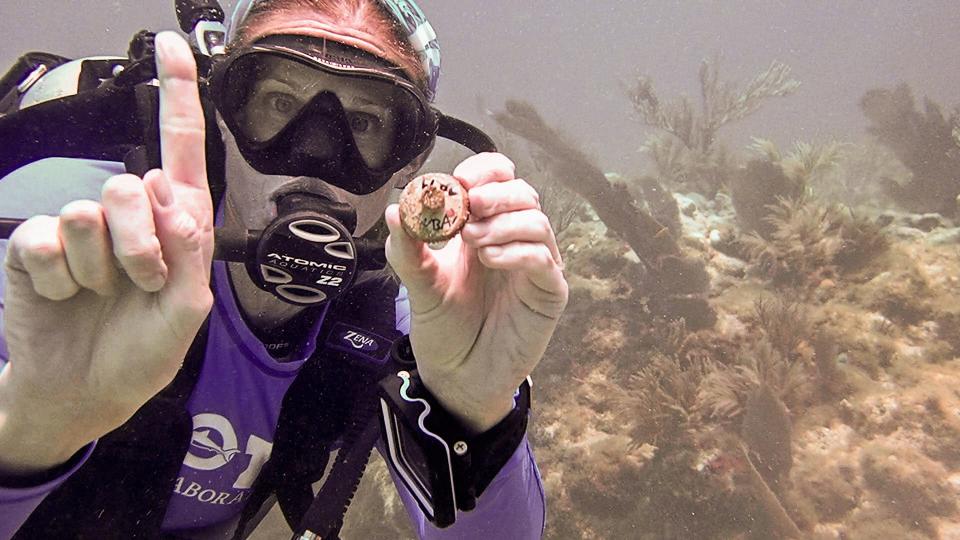
The land-based Islamorada nursery has grown from an initial 12 raceways to 20.
Related: Mote partners to expand coral restoration effort in the Keys
The nursery was established in the summer of 2020, during the COVID-19 pandemic.
That raceway will host micro fragmented coral that has been proven to be resilient in waters impacted by global warming, ocean acidification and, most recently, stony coral tissue loss disease, to plant on the reef.
Microfragmenting capitalizes on the natural healing process and allows corals to grow 25 times faster than normal. Coral is sliced into smaller pieces and attached to cement plugs.
Since those fragments are all genetically related, they will also grow together, to create an even larger coral shelf.
The first Elkhorn coral fragments from the satellite nursery – created on Nov. 11, 2021 during a celebration of the nursery’s opening – were planted at nearby Alligator Reef on April 28.
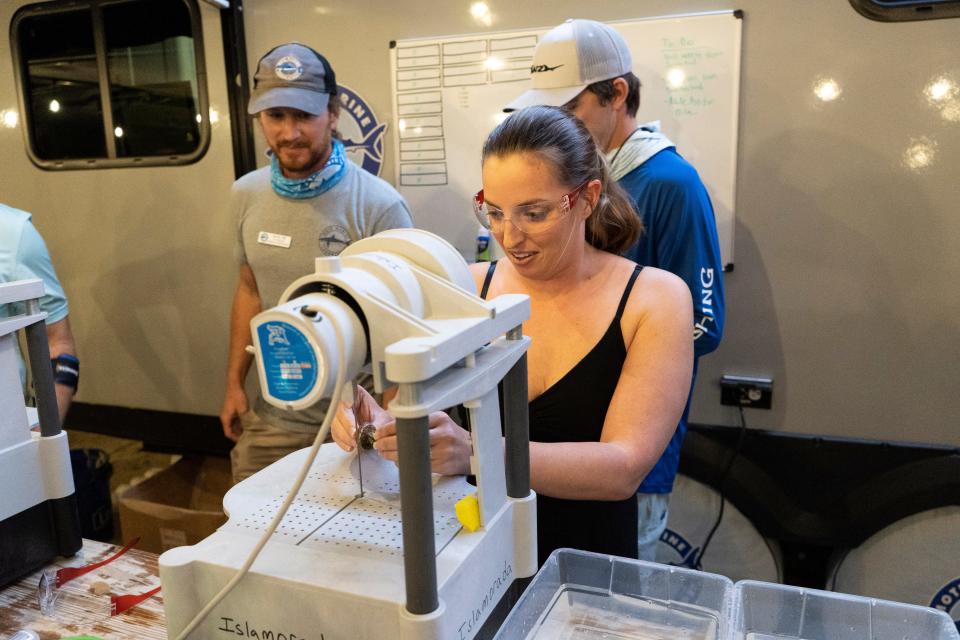
“We just did our one-month monitoring of those corals as well,” Hamlyn said. “They look fantastic – 100% are surviving; they’re looking really good.”
Hamlyn noted that because Alligator Reef, which is offshore of Bud ‘N Mary’s, is popular, the plan is to do several outplantings there.
“You can see it from the marina, it’s a really commonly attended reef, there’s a lot of dive boats that go there,” Hamlyn said.
Mote is also partnering with the Reefhouse Resort and Marina in Key Largo for a second land-based nursery in the upper keys.
That nursery, which will have 20 raceways when built out, will be used to repopulate coral at Cheeca Rocks, Horseshoe Reef and Carysfort Reef.
Currently there are more than 5,000 Elkhorn coral at Bud ‘N Mary’s in various stages of growth.. As many 8,000 fragments could fit there at any given time.
By the end of summer, Mote should also have field nurseries permitted and operating off Islamorada and Key Largo.
Mote has also applied for permits for crab cages at the nurseries, which would be co-located with the staghorn coral trees.
Staghorn coral provides habitat and complex shelter for the younger Caribbean king crabs.
"These guys will actually use staghorn colonies that are pretty complex as shelter,” Spadaro said.
Many questions unanswered
There is still much to learn about the Caribbean king crab. For example, researchers must still learn whether crabs captured in the upper keys are genetically compatible with those in the lower keys
“Corals, they're awesome broadcast spawning, their genetics mix naturally – crabs, we don’t know,” said Alicia Manfroy a Mote Coral Restoration Staff Biologist working with Spadaro on the crab project.
All the adult crabs at Mote were collected in the wild.
So far Big Red, an upper keys crab, has only been bred with upper keys female crabs.
In general Caribbean king crabs in the Florida Keys are significantly smaller than their cousins farther south.
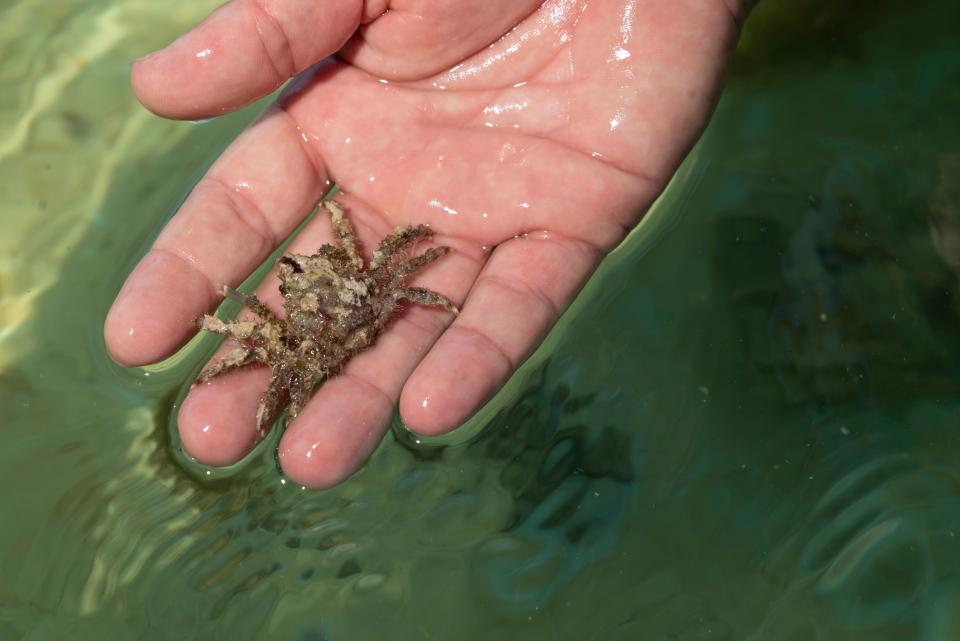
The scientists are still learning about the growth rate of crab babies and whether the presence or absence of certain cues in the water will impact that.
For example, long-spined sea urchins stop grazing and run for cover when they detect spiny lobster urine.
Spadaro and his wife Abigail Clark – who moved from Mote to his old position at the College of the Florida Keys – are planning to study whether that relationship is unique to lobsters and urchins or if it applies to other creatures.
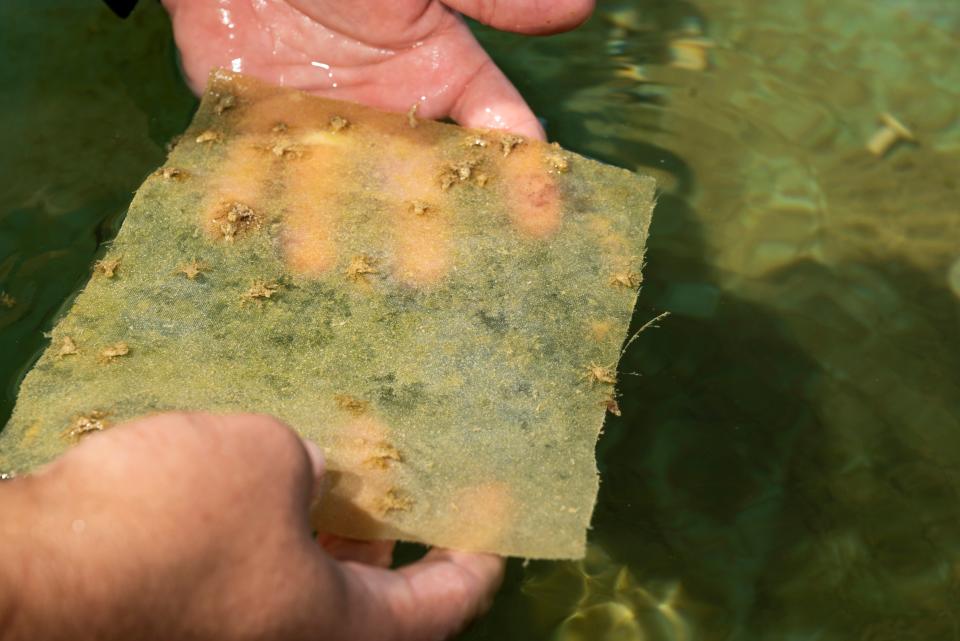
The scientist already learned that dirty, algae-filled aquarium tanks increase the survival rate of the babies – and that the crabs are an aquarist's dream, in terms of keeping a tank spotless.
In turn, larger tanks decrease the frequency with which crabs eat their brothers.
In another experiment involving crab larvae, Manfroy will study the impact of exposure to red and green algae as well as other cues such as water chemistry, to determine whether that increases the rate at which they molt and grow.
The scientists can then determine where the young crabs will prefer to settle in the wild.
Spadaro noted that they still also must establish the proper number of crabs needed to maintain a healthy reef
“You want the algae to still be there, just grazed and producing lots of food for fish and so on and so on,” Spadaro said.
Larger crabs are still tasty prey for octopus, sharks, grouper and snapper.
“Their density does predictably fall after you introduce them,” Spadaro said. “You try to balance that with how fast they remove algae and get them to wipe it off and hopefully you have a much lower stocking density as they move forward, to maintain that low algal cover as corals return.”
Earle Kimel primarily covers south Sarasota County for the Herald-Tribune and can be reached at earle.kimel@heraldtribune.com. Support local journalism with a digital subscription to the Herald-Tribune.
This article originally appeared on Sarasota Herald-Tribune: Caribbean king crabs could help rescue endangered Florida coral reefs

